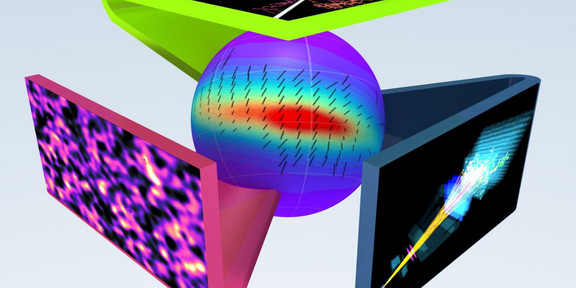DFG funding for the Collaborative Research Centre (SFB) 1491
- News
- Research

In the starry night sky, we see the same constellations year after year with the naked eye, so that the impression could arise that the universe is eternal and actually unchanging. However, at the latest since the discovery of the expansion of the universe and the cosmic microwave background - the residual radiation of the Big Bang - in the 20th century, we know that, on the contrary, we live in a very dynamic cosmos.
And this dynamic continues on all scales: stars form and pass away in violent supernova explosions and thus also influence their neighbourhood in the galaxies, sometimes even stimulating the formation of new stars. The explosions also create clouds of plasma, i.e. matter in which the electrons are separated from the atomic nuclei and which interacts with cosmic magnetic fields. In this way, individual particles can be accelerated to almost the speed of light and form so-called cosmic radiation, which also incessantly hits the atmosphere of our Earth. The interplay of cosmic matter that drives these processes is the leading topic of Collaborative Research Centre (SFB) 1491, which emerged from the activities of the Ruhr Astroparticle and Plasma Physics Center (RAPP Center): "How are the different forms of matter and energy transformed into each other? How are the smallest, elementary particles accelerated to the highest energies ever observed? How do large-scale magnetic field structures form in the plasma of galaxies? How can we better understand the mysterious dark matter and finally identify the particles it is made of?" says Prof. Dr. Julia Tjus, spokesperson of the new SFB from the Ruhr-Universität Bochum, naming some of the research questions.
16 internationally renowned researchers have joined forces to create a unified picture of the detectable traces of interacting matter. 11 researchers come from the Ruhr University Bochum, 4 work at the TU Dortmund University, and the Bergische Universität Wuppertal is involved with one researcher. They all want to understand the exciting processes that take place in our home galaxy, the Milky Way, but also in active galaxies, where matter flows onto the supermassive black hole located in the core of most galaxies. For this purpose, theoretical models of astrophysics are combined with experimental observations of all wavelengths and particles. Furthermore, the SFB provides knowledge about the fundamental properties of matter from theoretical calculations, cosmological observations and terrestrial experiments on particle interactions: "This knowledge can be used directly in the astrophysical models. The combination of the two research strands provides a detailed and precise picture of how galaxies function and evolve," comments Prof. Dr. Wolfgang Rhode from TU Dortmund University, co-spokesperson in the new SFB.
Cooperation partner
Understanding this interplay of cosmic matter is only possible if researchers from different fields of physics work together: At TU Dortmund University, cooperation between astrophysics and particle physics has long been established and successful, especially since state-of-the-art methods of data analysis and interdisciplinary findings in data science are also included. The project leaders involved at TU Dortmund University are: Prof. Dr. Johannes Albrecht, PD Dr. Dominik Elsässer, Prof. Dr. Dr. Wolfgang Rhode, and Prof. Dr. Bernhard Spaan. The links between the subfields of astro-, plasma-, astroparticle and particle physics in close cooperation between the participating universities have been investigated in the Ruhr Astroparticle and Plasma Physics Center (RAPP Center) since 2015. The work within the SFB will significantly advance research at the RAPP Center in the coming years.
Further information about the SFB 1491
Contact:










